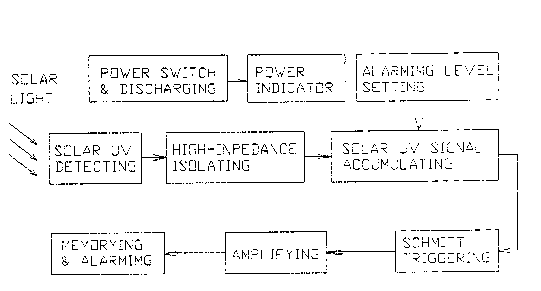Some of the information on this Web page has been provided by external sources. The Government of Canada is not responsible for the accuracy, reliability or currency of the information supplied by external sources. Users wishing to rely upon this information should consult directly with the source of the information. Content provided by external sources is not subject to official languages, privacy and accessibility requirements.
Any discrepancies in the text and image of the Claims and Abstract are due to differing posting times. Text of the Claims and Abstract are posted:
| (12) Patent Application: | (11) CA 2070165 |
|---|---|
| (54) English Title: | ALARM SYSTEM FOR SOLAR ULTRAVIOLET CAUSING SKIN DISEASES (ASSUV) |
| (54) French Title: | SYSTEME D'ALARME POUR LES RAYONS SOLAIRES ULTRAVIOLETS CAUSANT DES MALADIES DE LA PEAU |
| Status: | Deemed Abandoned and Beyond the Period of Reinstatement - Pending Response to Notice of Disregarded Communication |
| (51) International Patent Classification (IPC): |
|
|---|---|
| (72) Inventors : |
|
| (73) Owners : |
|
| (71) Applicants : |
|
| (74) Agent: | |
| (74) Associate agent: | |
| (45) Issued: | |
| (22) Filed Date: | 1992-06-01 |
| (41) Open to Public Inspection: | 1993-12-02 |
| Availability of licence: | N/A |
| Dedicated to the Public: | N/A |
| (25) Language of filing: | English |
| Patent Cooperation Treaty (PCT): | No |
|---|
| (30) Application Priority Data: | None |
|---|
Alarm System for Solar UltraViolet
Causing Skin Diseases(ASSUV)
Abstract
Because of the holes in the Ozonosphere near polars of
the earth, skin diseases caused by solar ultraviolet, such
as cancer, are becoming big threats to sun-bathers. This
invention is made to let sun-bathers enjoy sun shine without
worry. It is a device which calculates how much solar
ultraviolet one has already received, and gives alarm when
too much solar ultraviolet in a certain period has been
received.
Note: Claims are shown in the official language in which they were submitted.
Note: Descriptions are shown in the official language in which they were submitted.

2024-08-01:As part of the Next Generation Patents (NGP) transition, the Canadian Patents Database (CPD) now contains a more detailed Event History, which replicates the Event Log of our new back-office solution.
Please note that "Inactive:" events refers to events no longer in use in our new back-office solution.
For a clearer understanding of the status of the application/patent presented on this page, the site Disclaimer , as well as the definitions for Patent , Event History , Maintenance Fee and Payment History should be consulted.
| Description | Date |
|---|---|
| Inactive: IPC from MCD | 2006-03-11 |
| Inactive: IPC from MCD | 2006-03-11 |
| Inactive: IPC from MCD | 2006-03-11 |
| Inactive: Inventor deleted | 2002-05-22 |
| Inactive: Inventor deleted | 2002-05-22 |
| Time Limit for Reversal Expired | 1994-12-01 |
| Application Not Reinstated by Deadline | 1994-12-01 |
| Deemed Abandoned - Failure to Respond to Maintenance Fee Notice | 1994-06-01 |
| Inactive: Adhoc Request Documented | 1994-06-01 |
| Application Published (Open to Public Inspection) | 1993-12-02 |
| Abandonment Date | Reason | Reinstatement Date |
|---|---|---|
| 1994-06-01 |
Note: Records showing the ownership history in alphabetical order.
| Current Owners on Record |
|---|
| RU H. ZHAO |
| WEI GE |
| Past Owners on Record |
|---|
| None |